Antiques in Manchester: The Collector's Fair
August 6th, 2014
|
The Collector’s Fair transformed the ice rink.
Shaker specialist John Keith Russell of South Salem, New York, asked $1500 for the second-smallest New Lebanon production chair, circa 1875 (left). The tilting ladder-back chair was $3600 (center). The two-slat chair is a child’s chair. The Shaker broom was $1250.
Kelly Kinzle of New Oxford, Pennsylvania, asked $65,000 for this cottage-made suite of furniture made of white oak in the 1880s, probably for a summer lodge.
James L. Price of Carlisle, Pennsylvania, had a Pennsylvania walnut worktable in the center of his stand. The table was $9750. The copper teakettle by Keith F. Clark of Harrisburg, not polished, as antiquarians prefer them, was $2400.
Robert Snyder and Judy Wilson of Wiscasset, Maine, had a veritable farm stand of marble fruit and sold a lot of it. A slice of watermelon was $950; a peach, $325; and a walnut, $95. |
Manchester, New Hampshire
Karen DiSaia’s show Antiques in Manchester: The Collector’s Fair is designed for these times. It was small, short (afternoons on August 6 and 7), and focused on the best Americana that 47 dedicated dealers could muster for an audience hungry to buy.
The line for the noon opening was forming by 9 a.m. when Scott Cook arrived with his four border collies. He was first, second, or third in line for nearly every New Hampshire show, and he was soon joined by dozens of colleagues, who enjoyed sitting in the morning sun until they were invited to occupy the bleachers of the air-conditioned JFK Coliseum on Beech Street in Manchester, New Hampshire.
It was a gorgeous day—a perfect time to sit and discuss the latest finds with like-minded souls, people you hardly know, who love the hunt. Antiques Week in New Hampshire is the antidote to shopping on line.
The aisles were wide, and the stands were inviting. People came to the Collector’s Fair and stayed for hours. Many of them had a heads up because they had seen ads in trade papers and the previews on the Antiques in Manchester Facebook page and on the Web (www.antiquesin
manchester.com). The Web site and Facebook pages were updated and remained up after the show for those who needed a second look. Some made a beeline for what they needed to see before acquiring. Others checked each stand methodically.
DiSaia transformed the hockey rink into an intimate Americana bazaar that seemed to be a format for success. The dealers did their best to bring fresh things to market, often things from their own personal collections, because high quality is very hard to find. These things often sold first. Many dealers said they made half a dozen sales in the first hour. The opening was fast paced and had good energy as a steady stream of people filed in, looked carefully, and engaged dealers in conversations.
Dealers said there had been active buying at setup on Wednesday morning. It was the third year for this show, and only four dealers were new to the show: Joseph Martin of Brownington, Vermont; Robert Snyder and Judy Wilson of Wiscasset, Maine; the Smiths of American Sampler, Barnesville, Maryland, who wrote a book on cast-iron doorstops; and J & R Ferris Antiques, Boonville, New York, specialists in militaria, who also brought a large Rockwell Kent oil painting that was a show-stopper. Ferris took Paul Scott’s place at the last moment when Scott had a slow recovery from surgery, but Scott will be there next year. By the time the show closed at 6 p.m. on the second afternoon, dealers were happy. Many said selling was “like the good old days.” Both days were busy. Attendance was up significantly from the year before, and dealers made multiple sales.
What sold? Painted furniture, formal furniture, folk art, weathervanes, needlework, ceramics, glass, treen, watercolors, portrait miniatures, paintings, and all manner of small items found buyers. New Hampshire seems to be the last bastion of an Americana Week, where a cluster of five shows attracts serious collectors from all parts of this country and Canada. The enthusiasm is contagious, and the aim is not just to look but to buy. Only in New York City in January is there such a gathering of collectors, and there is no show in New York City focusing on affordable folk art anymore.
A two-day show seems just long enough to encourage buyers to make decisions quickly. Buyers know that in 48 hours they will miss their chance; the dealers will have packed up and gone away.
It was heartening to see such a large crowd of people seriously interested in so many aspects of Americana, and not all of them were elderly. Who said antiquing is a thing of the past? It seemed alive and energetic, prices were mostly realistic, and dealers were willing to deal, which makes for a healthy market.
 “There is nothing like this combination of shows in America. It is the best opportunity to see and buy Americana. The synergy is unique,” said Ian Berke, who with his wife, Maggie, came all the way from San Francisco.
“There is nothing like this combination of shows in America. It is the best opportunity to see and buy Americana. The synergy is unique,” said Ian Berke, who with his wife, Maggie, came all the way from San Francisco.
Why does this happen in Manchester? “Because it is summertime, no fancy parties, no dress-up. It’s antiquing like it used to be; it’s just fun,” said Pat Garthoeffner.
The pictures and captions show only a fraction of what was there. For more information, call (860) 908-0076 or e-mail <[email protected]>.
|
|
|
|
|
|
Originally published in the October 2014 issue of Maine Antique Digest. © 2014 Maine Antique Digest
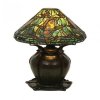




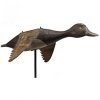






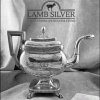









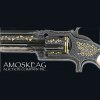
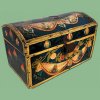






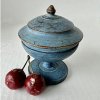







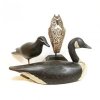

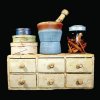
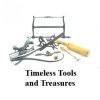
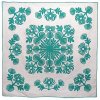







 Hilary and Paulette Nolan of Falmouth, Massachusetts, said this is the best weathervane they have ever owned. Made by A.L. Jewell in the first few years he was in business, it was $32,000. Hilary Nolan said he found it at Greenhill in Brookline, Massachusetts, where Isabella Stewart Gardner summered. The canvasback ducks were $3800. The chest in blue-green paint, from the Nolans’ personal collection, was $8500.
Hilary and Paulette Nolan of Falmouth, Massachusetts, said this is the best weathervane they have ever owned. Made by A.L. Jewell in the first few years he was in business, it was $32,000. Hilary Nolan said he found it at Greenhill in Brookline, Massachusetts, where Isabella Stewart Gardner summered. The canvasback ducks were $3800. The chest in blue-green paint, from the Nolans’ personal collection, was $8500.  Sam Herrup asked $17,500 for the carved and painted American monkey carriage used in circus parades to show off dressed-up monkeys; it is 36" long. The 42" x 47" x 24" hunt board of hard Virginia pine from the Piedmont or upper Shenandoah Valley, Virginia, 1820-30, was $7500.
Sam Herrup asked $17,500 for the carved and painted American monkey carriage used in circus parades to show off dressed-up monkeys; it is 36" long. The 42" x 47" x 24" hunt board of hard Virginia pine from the Piedmont or upper Shenandoah Valley, Virginia, 1820-30, was $7500. 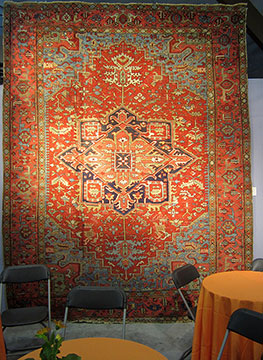 DiSaia Management hung some large Oriental carpets behind the large round tables where people gathered in the café, This 9' x 11'8" Gorevan Serapi, circa 1915, with good color and no restoration was $12,500.
DiSaia Management hung some large Oriental carpets behind the large round tables where people gathered in the café, This 9' x 11'8" Gorevan Serapi, circa 1915, with good color and no restoration was $12,500.







